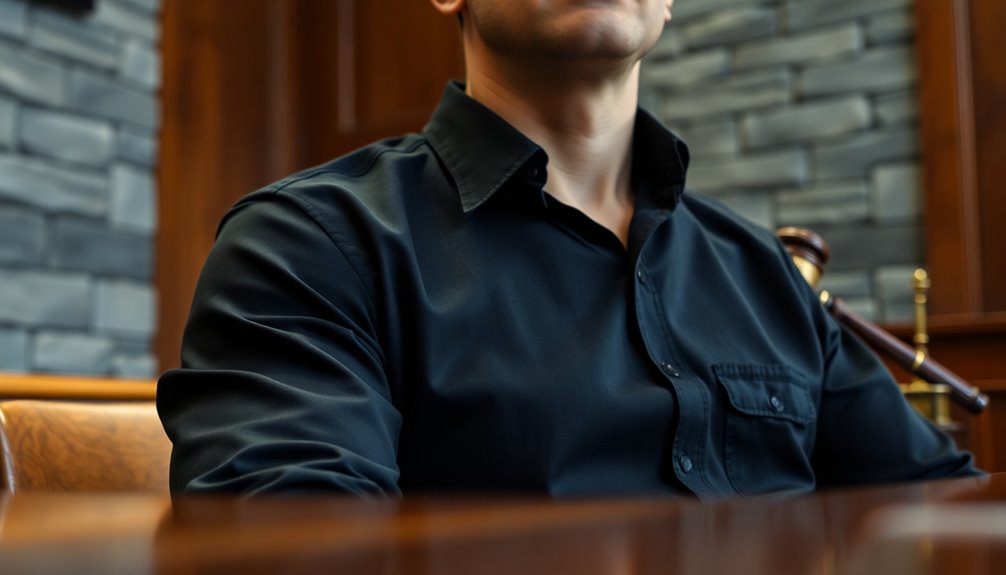Wearing a black shirt in court can greatly impact your case by altering perceptions of judges and jurors. Black often conveys arrogance or fear, which can undermine your credibility and may lead to assumptions of guilt. Studies show that jurors frequently judge based on appearance alone. Instead of a black shirt, you should opt for neutral colors like navy or gray that promote professionalism and relatability. Understanding how attire affects courtroom dynamics is essential. Exploring alternative attire options can enhance your chances for a more favorable outcome.
Summary
- Wearing a black shirt in court can evoke negative perceptions, suggesting arrogance or fear, and may undermine your credibility.
- Jurors often judge defendants based on appearance, making clothing choice critical for case outcomes.
- Black can be interpreted as indicative of guilt, impacting juror sympathy and trust.
- Professional attire in neutral colors like navy or gray fosters respect and can positively affect courtroom dynamics.
- Seeking legal counsel for attire advice ensures compliance with court expectations and enhances relatability to jurors.
Understanding the Impact of Clothing Color in Court
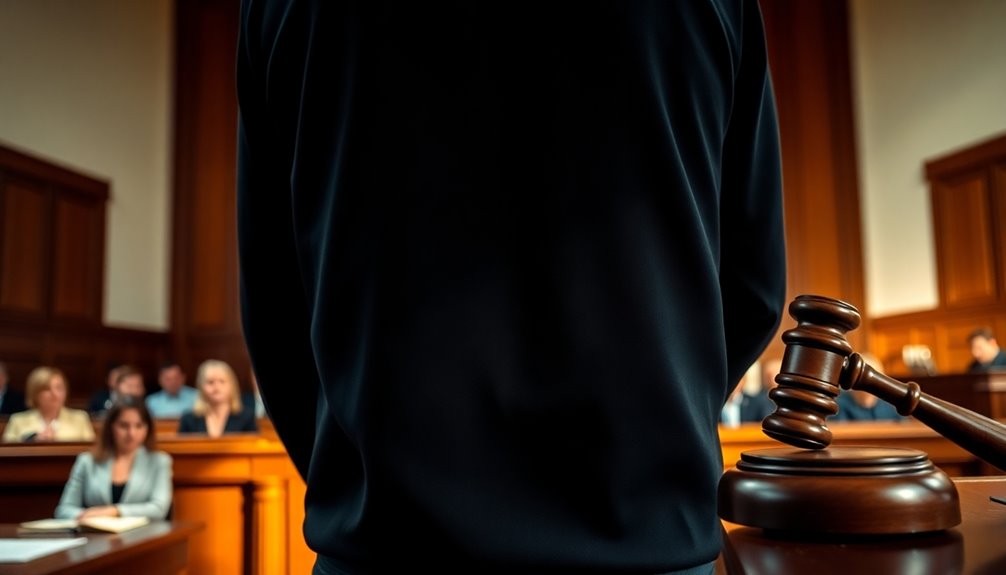
Clothing color plays an important role in shaping perceptions within the courtroom. The impact of clothing color in court can greatly influence how you're perceived by judges, jurors, and attorneys.
Wearing black, while often associated with authority, can also evoke negative connotations like fear and arrogance. This creates the potential for a negative first impression, which could undermine your credibility. Studies show that jurors may judge based on appearance alone, further emphasizing the significance of color choice. Additionally, wearing dark, neutral colors like navy or gray promotes professionalism and stability, which can enhance your case's overall presentation. Proper attire helps focus attention on the case rather than appearance, ensuring that your message is delivered without distractions. In legal settings, maintaining a conservative appearance is crucial for fostering trust and respect.
Colors to avoid in court include bright or loud hues, as they can signal aggression or distract from the case. Such attire might suggest a lack of seriousness about the proceedings, further harming your court appearance first impressions.
Instead, opting for neutral or dark colors like navy blue or gray promotes professionalism and stability. These colors not only convey respect for the court but also reflect positively on your character.
Ultimately, the color you choose for your court appearance can affect the outcome of your case. A thoughtful selection of attire can enhance your credibility and foster a more favorable perception, making it essential to reflect on the psychological effects of color in legal settings.
Best Colors to Wear as a Defendant in Court
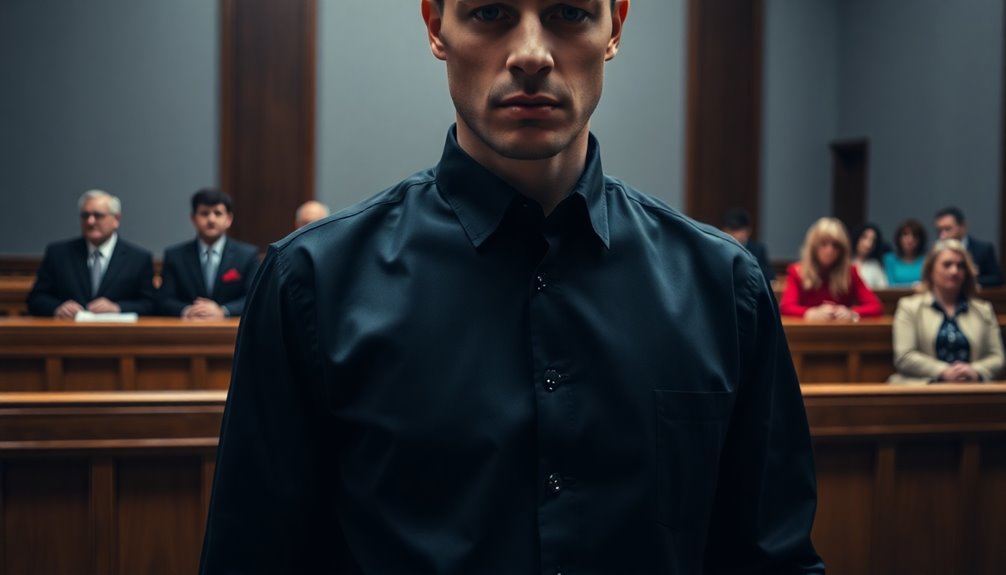
What colors should you consider wearing as a defendant in court? The best colors to wear to court are those that convey seriousness and respect for the judicial process.
Navy blue stands out as an ideal choice, reflecting serenity and thoughtfulness. Dark gray is another excellent option, suggesting professionalism without negative connotations. White offers a neutral and professional appearance, while beige can convey humility. Earth tones like dark brown are also generally acceptable for conservative court attire. Darker suits are preferred for men, which enhances the overall professionalism. Dressing appropriately can also show respect for the legal system, reinforcing your commitment to the court process. Maintaining a neat and professional appearance is crucial in court as it impacts the overall impression you make.
In contrast, there are specific colors to avoid in court. Black, often associated with authority, should be left out of your wardrobe. Bright colors such as red, orange, and yellow may come across as provocative, while neon shades can be distracting and disrespectful.
Pastel colors might appear less formal, and green often carries varying cultural interpretations that could lead to misunderstandings.
Understanding the importance of courtroom attire is vital. Your clothing choices should reflect a serious demeanor, helping to establish a positive impression.
Why Black Shirts Are Considered Inappropriate in Court

Choosing the right attire for court can greatly impact how you're perceived by judges and jurors. Wearing a black shirt as court attire can send the wrong message in a legal setting. While black is often associated with power, it can also convey an air of superiority that may not be beneficial for a defendant. Judges and jurors may interpret black as intimidating or even suggestive of guilt, which undermines your intended humility and respect for the court. Understanding color psychology can help you select attire that enhances your confidence and aligns with the courtroom's expectations.
Court appearance advice emphasizes the importance of making a good first impression. Your clothing reflects your attitude towards the seriousness of the case. Inappropriate attire, like a black shirt, may imply a lack of concern for courtroom decorum. Wearing appropriate attire demonstrates respect for the judicial process and its decorum, further influencing how your case is perceived. Professional, conservative attire enhances confidence and shows that you take the proceedings seriously.
Color psychology in court shows that neutral and lighter colors, such as white, navy blue, or gray, are more favorable. These colors project stability, professionalism, and credibility, positively influencing juror perceptions.
Alternatives to Black: Choosing the Right Court Attire
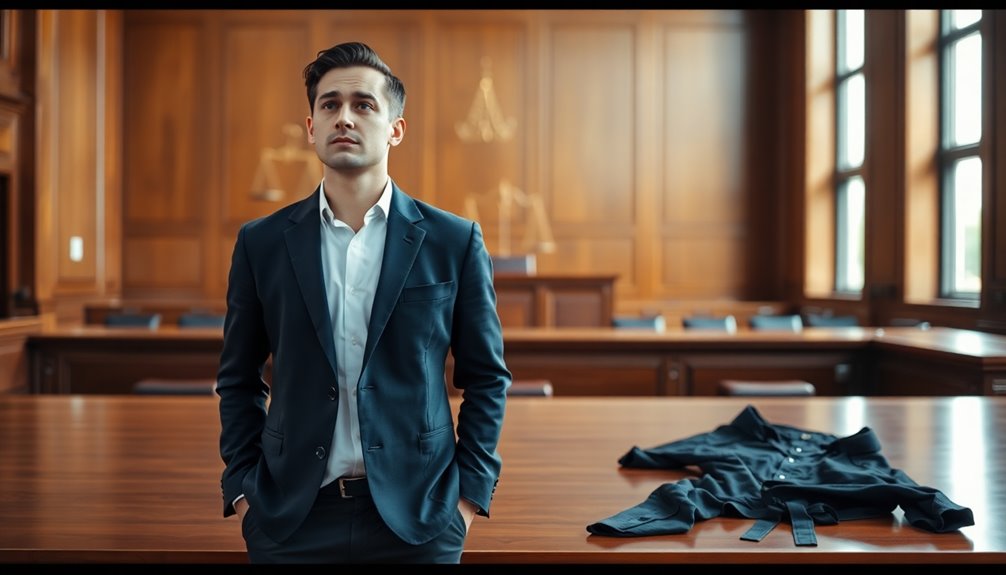
Selecting the right attire for court can greatly influence how you're perceived by judges and jurors. When considering court appearance clothing, it's crucial to prioritize professionalism and respect for the judicial process. Proper attire can demonstrate respect for the court, which is vital in establishing credibility. Wearing colors that convey professionalism and reliability can further enhance this perception.
The best colors to wear to court include neutral shades like navy blue, gray, and white. These colors convey seriousness and are less likely to evoke negative connotations associated with darker hues like black. Dressing appropriately can significantly impact case outcomes, emphasizing the importance of your clothing choice.
Court outfit suggestions typically recommend business or business casual attire. For men, a collared shirt paired with long pants is ideal, while a suit and tie can enhance formality.
Women should opt for dresses or blouses with skirts or long pants, making sure their clothing is modest and conservative.
When dressing for court, avoid casual wear like jeans, shorts, or t-shirts, and make certain your shoes are closed-toe dress shoes. Keep accessories minimal to maintain a polished look.
Remember the court appearance dos and don'ts: steer clear of distracting patterns, avoid hats and sunglasses, and maintain personal hygiene.
If you're uncertain about your attire, consulting with an attorney can provide valuable guidance.
The Psychology Behind Colors and Perception in Legal Settings
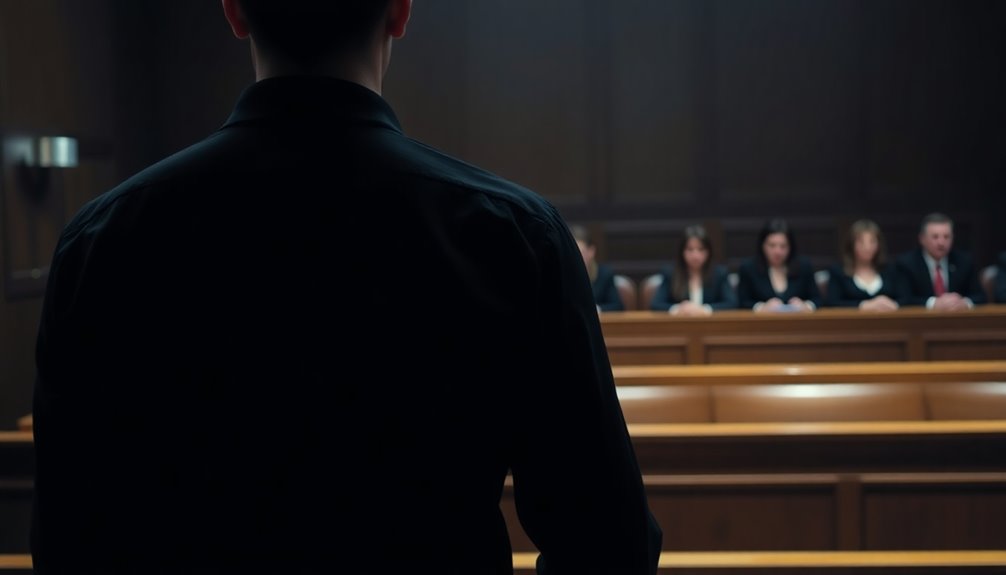
The psychology behind colors in legal settings plays an essential role in how defendants are perceived by judges and juries. Your choice of court attire can greatly impact the perception of your character and intentions.
For instance, wearing black, while formal, may convey negative connotations such as fear or superiority, which aren't ideal traits for a defendant. This attire could lead to a perception of being less sympathetic, potentially undermining your credibility in the eyes of the jury.
Conservative choices in clothing, such as neutral colors like navy or gray, can help humanize you and enhance your relatability. This approach signals respect for the court and demonstrates an understanding of courtroom decorum.
The impact of clothing in court extends beyond mere appearance; it influences how you're treated and how seriously your case is taken.
Tips for Dressing Professionally for Your Court Appearance

Often, defendants overlook the importance of dressing professionally for court appearances, yet it can greatly influence the perception of their character and credibility. When facing serious charges, you should prioritize court attire that reflects professionalism.
Opt for neutral colors like navy blue, gray, or white, as these convey stability and respect. Avoid black unless it's part of a full suit, as it may evoke negative connotations.
Dressing conservatively for court is key. Steer clear of casual clothing like jeans and t-shirts. Instead, choose neat, well-fitting attire that maintains a polished appearance. Dark leather shoes complement your look and further enhance professionalism.
Additionally, make sure your hair is groomed and avoid hats or sunglasses, as these can be seen as disrespectful. Remember that dressing appropriately can also reflect your respect for the court and the legal process.
As a part of your court appearance tips, remember that first impressions matter. Avoid distracting clothing with patterns or logos, which might divert attention from your case.
Common Misconceptions About Court Dress Codes
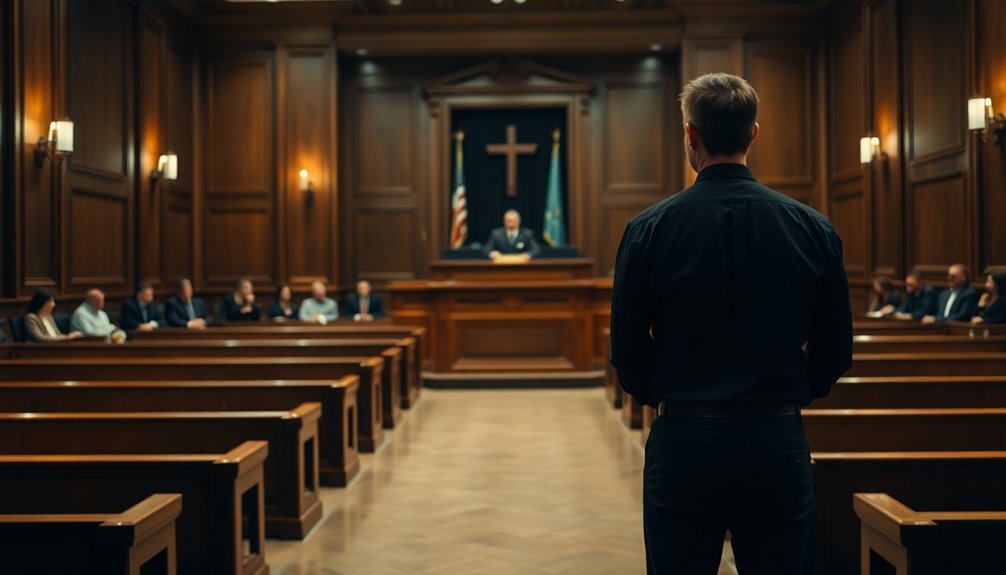
When it comes to court dress codes, many individuals harbor misconceptions that can lead to inappropriate attire choices. One common error is mistaking formality for neutrality. While formal wear for court, like a black shirt, may appear authoritative, it can also evoke negative associations of power and aggression. Instead, consider court appearance color choices such as navy blue or gray, which are seen as more neutral and professional. Additionally, adhering to color choices that stick to neutral tones like black, navy, gray, or brown can help convey professionalism and seriousness. Wearing colors like blue can help convey a sense of trustworthiness, which is especially important in a courtroom setting.
Another misconception is overemphasizing personal expression. Court etiquette clothing should prioritize respect and formality over bold statements. Dressing conservatively not only demonstrates legal etiquette for clothing but also avoids distractions that could detract from the case.
Additionally, failing to check specific court guidelines can lead to missteps. Dress codes can vary by location, and casual or revealing clothing is generally deemed inappropriate.
Consulting Your Lawyer on Appropriate Court Attire

Consulting your lawyer about appropriate court attire is essential for making a positive impression in the courtroom. Your lawyer's expertise can guide you on local dress codes and the specific expectations of the judge overseeing your case.
Since courtroom environments vary, understanding these nuances can considerably impact how you're perceived. Factors such as the type of case and the judge's preferences can influence attire choices.
Common lawyer recommendations often include conservative colors like navy blue, gray, or beige, which project professionalism. It's imperative to avoid casual wear, as jeans and t-shirts might convey a lack of respect for the court.
Discussing your attire during pre-trial meetings allows for tailored advice that aligns with your case strategy. Your lawyer might even offer to review your outfit before the court appearance to guarantee it meets expectations. Additionally, wearing colors like blue or gray can help you convey professionalism and reliability.
FAQ
Can I Wear Casual Shoes With My Court Attire?
You shouldn't wear casual shoes with your court attire. Opt for polished, formal shoes that convey professionalism. Your footwear choice can influence perceptions, so make certain it aligns with the seriousness of the courtroom environment.
Is It Acceptable to Wear Accessories to Court?
You can wear accessories to court, but keep them minimal and subtle. Focus on pieces that enhance your professional appearance without drawing attention. Avoid anything flashy or distracting to maintain respect for the judicial process.
Should I Avoid Wearing Denim in Court?
Yes, you should avoid wearing denim in court. It's considered too casual and can negatively influence perceptions. Opt for formal attire that conveys respect for the court and shows seriousness regarding your case.
Can I Wear a Hat or Head Covering in Court?
You can't typically wear a hat or head covering in court unless it's for medical or religious reasons. Judges expect respect and decorum, so choose your attire wisely to avoid distractions and negative impressions.
How Should I Handle Clothing Stains Before My Court Appearance?
You should act quickly to treat any stains before your court appearance. Pre-treat stains, wash clothes thoroughly, and inspect your outfit carefully to guarantee a clean, professional appearance that respects the court's environment.
Final Thoughts
To summarize, the color of your attire can greatly influence perceptions in a courtroom setting. While a black shirt might seem like a neutral choice, it often carries negative associations that could detract from your case. Opting for lighter, more professional colors can help convey respect and enhance your credibility. Ultimately, being mindful of your clothing choices, in consultation with your lawyer, can positively impact how you are perceived by the judge and jury.
